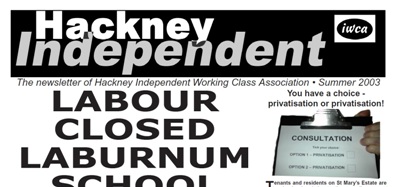Londoners Demand Share of Olympic Gold
Posted: January 31, 2004 Filed under: Olympics Comments Off on Londoners Demand Share of Olympic GoldIn an article from the Guardian, TELCO (East London Communities Organsiation) make some interesting demands on the strategists behind London’s Olympic bid for 2012, demands that the IWCA would probably share in many ways. With the first of many promises broken by planners (proposing car parks on Hackney Marshes and forcing the possible closure of Sunday League football there) can we expect them to seriously take into account the views and needs of Hackney’s working class majority? TELCO’s demands are a positive step, but we can’t be under any illusions that the developers and planners will really listen to us in the long run.
Cast iron guarantees of jobs, wage levels and proper compensation are being demanded by residents and businesses in London as the price for their cooperation with Britain’s Olympic bid.
As officials formally submitted the Olympic proposals for planning consideration, campaigners in east London have submitted a list of minimum requirements to ensure local people benefit from the massive regeneration promised.
They complain that residents in the most affected boroughs – Newham, Tower Hamlets, Hackney and Waltham Forest – were overlooked during the redevelopment of Docklands, Canary Wharf and the Millennium Dome.
Many of the new properties were bought by outsiders and property speculators. The expectation that locals would get new, highly skilled jobs, failed to materialise.
Three hundred companies will be displaced as well as London’s biggest church, the Kingsway International Christian Centre. Land owned by a Muslim Alliance could also be affected, including the proposed site of what would be the largest mosque in Europe.
As part of their campaign for a series of “people guarantees”, the East London Community Organisations group (Telco) has told the organisers that all jobs in the Lower Lea Valley – site of the proposed Olympic zone – must pay at least £6.70 an hour.
Telco, which has 40 smaller groups under its umbrella, says all of the highly lucrative construction contracts must include clauses ensuring that at least 30% of the labour will be local. Local schools and health services must benefit from “planning gain”, whereby private firms agree to fund social improvements.
Activists also want a share of the highly paid skilled jobs. Telco wants a guaranteed sum allocated by the Learning and Skills Council to make sure locals can compete. They want a community land trust to administer housing schemes, including homes built for the Olympic village.
Affordable family housing must be set aside for those already living in the affected boroughs. Campaigners want East London University to become a sporting centre of excellence and to take responsibility for the future use of Olympic facilities.
Neil Jameson, a Telco organiser, said: “We must have these guarantees written in from the outset because history teaches us that without them we will be overlooked. We have been regularly promised bread and circuses. Historically we get the circuses but not the bread.”
“There is support for the Olympics but on our terms.”
The planning blueprint is to be considered by a committee of councillors from the four boroughs. Their task is complicated by the fact that the detailed planning application was submitted behind schedule.
Opinion polling carried out for the mayor of London, Ken Livingstone, strongly suggests that Londoners support the capital’s bid for the games.
The proposed Olympic village in Stratford will leave a legacy of 5,000 homes and a giant aqua centre.
Some venues could be dismantled serving the purposes of local planners, who are reluctant to base their regeneration plans on buildings which may have little relevance after the games.
Neale Coleman, Mr Livingstone’s policy adviser on the Olympics, said he shared many Telco aspirations. “Certainly we hope to achieve higher employment and skills training in construction and a range of other jobs than achieved by similar projects.
“When people talk about the legacy of the Olympics they usually refer to buildings, but the real legacy is homes and jobs for local people. These things are important to the International Olympic Committee.”
Sink or swim in the Basin
Posted: June 15, 2003 Filed under: Gentrification / Regeneration, Media, Olympics Comments Off on Sink or swim in the BasinBelow we reprint an article from The Guardian about regeneration in London. It’s particularly interesting in the light of London’s proposed bid for the Olympics and the push by Labour to get Hackney people supporting it. This article asks the question, do local people benefit from regeneration schemes.
A multi-million pound development is creating 30,000 jobs in a run down area. But, reports Colin Cottell, local people are missing out on the much-needed work
A flagship project with the promise of jobs for the long term unemployed. What could be better for a deprived area of London that sits next to pockets of incredible wealth, but never seems to benefit from the ripple effect?
Occupying a site the size of 60 football pitches three miles west of Oxford Street, Paddington Waterside is a gleaming collection of offices, upmarket homes and holes in the ground that will turn into yet more gleaming offices and upmarket homes. Out goes the seedy prostitution and bedsits image that has dogged the area and in comes shiny 21st century living.
Like east Manchester after the Commonwealth Games, Paddington Waterside is supposed to turn an employment desert into a thriving part of town, creating an extra 30,000 jobs.
Mobile phone company Orange is building its new European headquarters building, the Point, next to one of the canals that run through Paddington. Marks & Spencer is also moving its HQ to the area. Just 11 acres of the site, bought for £85m by a developer, will see £600m spent on it before completion.
Yet on a sunny afternoon last week, two young men kicking a football about on a local council estate, less than half a mile away from the main Paddington site, say they have missed out.
Although in its brief history the regeneration of the area has already spawned several thousand jobs, neither men say that they or residents on the estate have gained anything.
“I don’t know anyone who has found work at Paddington Basin,” says Mark Bradshaw, aged 22. Mr Bradshaw has been in and out of work for the past four years.
“Lots of my mates on the estate are out of work,” he says. What about the construction companies who say they are crying out for people? “They are lying,” he says.
Who to believe? Those who say that urban regeneration projects such as Paddington Waterside bring jobs and prosperity to nearby communities or those who complain that it always the locals who lose out?
One thing is certain, however. More than a decade after Canary Wharf put urban regeneration on the political and social agenda, the question of who gains from massive projects such as Paddington Waterside, and a host of others, including London’s Olympics bid, shows no signs of going away.
Sue Hinds, head of community employment at the London Borough of Tower Hamlets, home to Canary Wharf, says the answer to people who ask if local people are winners is “yes and no”. She adds: “It depends who you talk to. Some employers will think that local people won’t have the skills they need. Some local people will think the jobs are not for them.”
However, in Tower Hamlets as elsewhere the hard facts tell their own story. Employment, including 5,000 construction jobs, may have risen to 60,000 at Canary Wharf, but in its shadow there are around 9,000 residents out of work.
Granted, unemployment has come down, but at around 12% it is still more than twice that of London as a whole, says Ms Hinds, and excludes the large number of people of working age who are economically inactive – including 57% of women.
According to Robert John, an adviser to Canary Wharf, around 7.5% of those employed at Canary Wharf live in Tower Hamlets, up from 4.5% in 1997. But compare the actual number of non-construction jobs held by Tower Hamlets’ residents – around 3,000 in 2001 – with the 150,000 jobs in the borough, and it is clear that there is still along way to go.
The situation has improved as local people’s aspirations have risen, says Mr John. However, more still needs to be done. “We need to work on ways of making places like this not hostile to local people,” he says. “It is not that are there are no jobs, or a lack of opportunities, but poverty of attainment. People have low aspirations. They don’t think they will get those jobs,” says Colin Middleton, program manager at the City Fringe Partnership, which works in deprived areas such as Hackney. However, everyone involved in regeneration agrees that limited aspirations are only part of the problem.
There is a mismatch between the skills employers require and those possessed by local communities, says Mr Middleton. “The skills needed are NVQ Level 4 and above. The majority will have NVQ Level 2 or below.”
Mike Noakes, general manager for BAA Rail, which operates the Heathrow Express at Paddington station, admits: “We do have to look further afield sometimes. High customer service type skills are required for frontline positions such as drivers and staff who work on the trains, and sometimes these are the ones local people don’t have.
“Some of these jobs have been filled by locals, but not so many up to date,” he says. Jobs such as baggage handlers have been easier to fill locally, he adds.
For other employers the only criterion is ability to do the job. “We don’t see it as whether someone is an insider or an outsider, but will they make a decent lawyer or not? The postcode is absolutely irrelevant. We wouldn’t employ someone just because they lived on the Isle of Dogs,” said Iain Rodger, Head of PR at legal firm, Allen &Overy, who employ 200 staff at Canary Wharf.
Nigel Hugill, chairman of Paddington Waterside Partnership, the private sector lead consortium redeveloping Paddington, says that as unemployment has fallen the task of getting the remaining jobless into work has become more difficult.
Kay Buxton, the Partnership’s chief executive, says they have made progress in helping local people to compete.
Since 1999, Paddington First, their non-fee jobs agency has helped find work for over 2,500 people. “Some 40%-50% of people getting jobs through Paddington First live within two miles of Paddington Waterside, and 60% live within [the public transport] zones one or two,” she says.
Employers involved in the Paddington development are doing their bit. All the main contractors and sub-contractors have agreed to advertise their vacancies with Paddington First.
It was generally easy to recruit local people, says Trevor George, construction manager for Wates Construction, who following a customised training course took on three of the 12 trainees employed. Mr George says that the experience left him “pleasantly surprised.”
However, according to John Hodson, director of programmes at Renaisi, a not-for-profit organisation specialising in regeneration, the beneficial effects of large scale construction projects on local employment are often limited. “The contracts are tendered out to major companies and a small proportion will go to local residents,” he says. And even where companies set up training programs, the numbers involved will be “a small proportion of the total workforce”, maybe 20% on a major construction site.
Higher up, the situation is even worse, says Caroline Masundire, managing director of regeneration recruitment consultants Chase Moulande. Despite a severe shortage of planners and surveyors, she has never known a local person get one of these jobs. “It’s men in suits – people who move in for two years and then bugger off.” At least that’s what communities think, she adds.
Even where locals do find work it may be short-lived, says Ms Hinds. “The anecdotal evidence is that people are not staying in their jobs. Most of the unemployed have been out of work for between four months and a year. People get jobs, then go back to being unemployed.” Other anecdotal evidence shows that when local people get well-paid decent work they move out of the area to “somewhere a bit greener,” she suggests.
Figures from Canary Wharf back this up. “Between 1997 and 2001, 640 people moved out of Tower Hamlets after starting work at Canary Wharf,” says Mr John. Those people who move in, by contrast, tend to be “at the top of the deprivation ladder,” says Mr Middleton. “So it starts again – a vicious circle.”
Professor Andrew Church, from the geography department at the University of Sussex, adds: “The community changes as the development occurs.” And because new groups moving into an area may not have the skills necessary to take up the available jobs local unemployment remains high.
Ms Hinds accepts that consistently shifting populations are a reality of inner city life and that this makes it difficult to reduce unemployment for good.
Nevertheless, she remains optimistic. “I think it is changing slowly. But it is changing,” she says.
Whether such change ultimately leads to local people getting their fair share of jobs remains to be seen.




Recent Comments